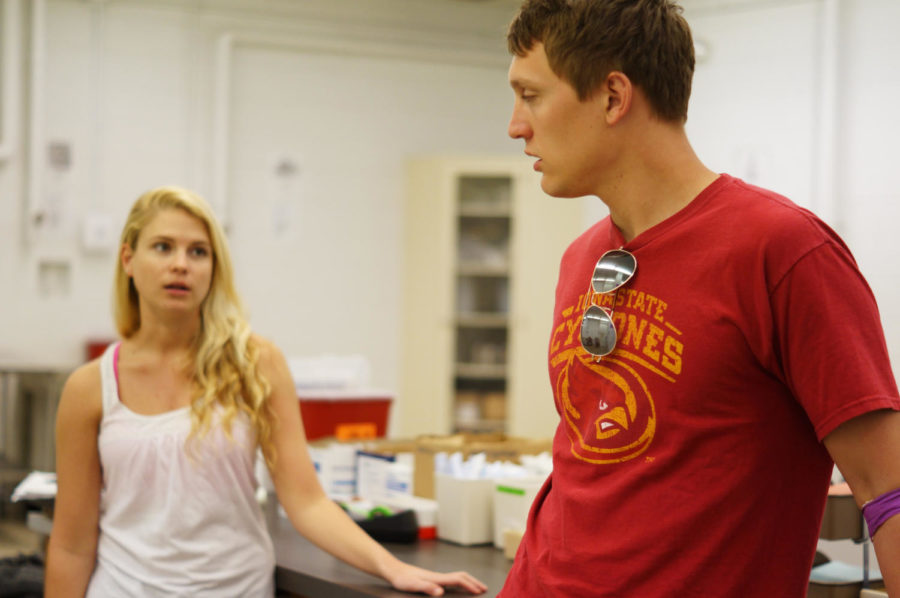Feral Cat Alliance benefits both animals and veterinary students
May 3, 2013
One un-spayed female cat and her offspring can produce 420,000 cats in only seven years, but veterinary students participating in the Feral Cat Alliance clinics are doing their part to help the overpopulation of feral cats.
The Feral Cat Alliance is an organization at Iowa State’s College of Veterinary Medicine that is dedicated to serving Iowa communities by humanely controlling the feral cat population.
The organization holds monthly clinics for the public to bring in their feral cats to be spayed or neutered.
During the clinics, first- through fourth-year students perform the surgeries, which are supervised by certified veterinarian clinicians.
“The main focus of the program and clinics is to reduce the feral cat population numbers,” said Jillian Sweet, co-chairwoman of the Feral Cat Alliance at Iowa State.
Feral cats are classified as outside cats that have been abandoned, that are wild or strays and who are not owned by anyone specifically.
Feral cats are a danger to the cat population because if they cannot be caught for veterinary care, they can easily spread diseases and breed.
During the alliance’s monthly clinics, students spay and neuter roughly 25 to 30 feral cats and hold approximately 10 to 12 clinics a year.
“People come from all over the state, sometimes from up to three hours away,” said Jordan Yesesky, co-chairman of the organization.
Along with spaying and neutering feral cats, the students administer veterinary care such as checking for fleas, ear mites, diseases, conducting blood work and checking for heartworms.
“We want them to leave us better than when they came in,” Sweet said.
The cats that come into the clinics differ greatly.
“Some cats are more feral than others. Generally, there are ones that are feral, but people feed and pet them every day. And then, there are cats that have never had contact with another person,” Yesesky said.
The Feral Cat Alliance is student-run and is a nonprofit organization.
“We run off of all donations, and so one of the preparations is reaching out to see if we can get donations,” said Sarah Lord, president of the group.
When cats are brought in to be spayed or neutered, there is a recommended $20 donation, and other donations are accepted and welcomed as well.
“Old towels and blankets are appreciated because we go through those relatively quickly,” Yesesky said.
The clinics held by the Feral Cat Alliance obviously benefit the feral cats, but they also benefit the veterinary students.
“It’s a big learning experience for the students. All of the students are doing the prep and the surgeries. So, it’s a win-win situation for the community and the students,” Lord said.
The organization usually tries to get a veterinary student from each year to a group and have roughly 10 groups per clinic working on the cats.
During the clinics, the students must be supervised by a certified veterinarian clinician to make sure the surgeries are completed to the veterinary standards.
“The biggest task is getting clinicians, because even though the students are doing everything, we still need someone who’s certified to oversee the procedures, and getting the clinicians is one of the hardest tasks,” Sweet said.
The veterinary students gain hands-on experience through participating in the clinics.
“The vet students are learning tons. You won’t get experience like this until your fourth year. So, the fact that we get to handle the live animals is amazing,” Yesesky said.
Along with controlling their population, the cats benefit from the medical attention.
“Most of these cats have never seen veterinary care before. So, the fact that we take them in and [make] sure their blood work is normal is great for these animals,” Lord said.
In addition to the monthly clinics, the Feral Cat Alliance has a “mega clinic” once each year.
“The mega clinic will be at the end of September this year, and it’s when we try to see around 120 cats, and we try to get the cat population down during these large clinics,” Sweet said.
Those interested in bringing a feral cat in for care can call (515) 294-2102 and leave a message with contact information or email the Feral Cat Alliance at [email protected].
The next spay and neuter clinic is May 18, 2013.

















